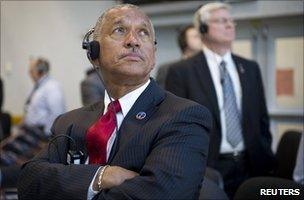Shuttle Discovery sets out on last voyage
- Published
The US Discovery blasts off from the Kennedy Space Center
The US shuttle Discovery has launched from the Kennedy Space Center for the last time.
The orbiter roared into a bright blue Florida sky, leaving the pad at 1653 local time (2153 GMT).
Its 11-day mission will see it deliver a new store room and a sophisticated humanoid robot to the International Space Station (ISS).
Only two further flights remain by Endeavour and Atlantis, which Nasa wants concluded in the coming months.
The orbiter fleet will then be retired to museums.
As usual, huge crowds had gathered on all the approach roads leading to the Nasa facility, along the Banana River and on the beaches lining Florida's Space Coast - everyone wanting to witness a piece of history.
They all had to wait a little longer than scheduled - the final countdown was delayed by three minutes as a problem was fixed with the computer system that tracks the shuttle to orbit.
As soon as the issue was resolved, ground controllers restarted the clock and radioed to Discovery's crew: "Enjoy the ride". Shuttle Commander Steve Lindsey replied: "We appreciate all your work; and for those watching, get ready to witness the majesty and the power of Discovery as she lifts off one final time."
Discovery is regarded as the "leader of the fleet", and was entrusted with both return-to-flight missions following the Challenger and Columbia accidents.
First launched in 1984, this is its 39th outing. When it lands back on Earth in nearly two weeks' time it will have covered a cumulative career distance of 230 million km (143 million miles). That's further than the distance from the Earth to the Sun (149 million km).
Once the shuttles are retired, the plan is for US astronauts to fly to the space station on Russian Soyuz rockets until perhaps the middle of the decade.
A number of American companies then hope to be in a position to sell launch services to Nasa on a range of new vehicles.
The intention is that the agency should put its efforts into leading the development of a large rocket - known as the Space Launch System - that can send astronauts beyond the space station to destinations such as asteroids.
Congress has set out the broad capabilities it expects to see in this rocket and has given a deadline of 2016 for its introduction. However, Nasa has said it cannot deliver such a vehicle in the time and with the budget the politicians have specified.
As well as Steve Lindsey, Discovery's crew includes Eric Boe as the pilot. They are joined by mission specialists Alvin Drew, Michael Barratt, Nicole Stott and Steve Bowen. Bowen was called in late to replace crewman Tim Kopra who was injured in a bicycle accident last month. He becomes the first astronaut to fly on successive shuttle missions, having also crewed the previous Atlantis mission.
A key task for Discovery will be to deliver the Italian-built logistics module known as Leonardo. The module, which is used as a packing box for supplies in the orbiter's payload bay, would normally return to Earth with every shuttle mission, but for Discovery's flight it will be left on station to provide extra storage space.

Nasa Administrator Charles Bolden watches Discovery make its final lift-off
Leonardo's retention on the ISS represents yet another remarkable achievement for Thales Alenia Space in Turin, which has produced most of the pressurised volume, or living space, on the US side of the platform. Appropriately, Italian and European Space Agency astronaut Paolo Nespoli will be onboard the station to help fit Leonardo into place on the Unity connecting node.
There has been particular interest in a "passenger" being carried up in Leonardo. This is Robonaut 2, or R2, the first human-like robot in space.
R2 is the product of 15 years' research in Nasa and General Motors.
In its current guise, the robot is just a head, arms, and a torso mounted on a pedestal. But the plan eventually is to give R2 some legs to let it move around the station. And in a couple of years, it will also get a body upgrade that should significantly advance its capabilities.
The expectation is that before the decade is out, this robot will be clambering about on the outside of the space station, assisting astronauts on spacewalks. Inside the station, R2 is likely to take on many mundane tasks such as cleaning.
Discovery should arrive at the ISS on Saturday. The first of two spacewalks to carry out maintenance tasks on the exterior of the platform should occur on day five of the mission.
Shuttle Endeavour is expected to fly to the station in April. Atlantis will go no earlier than June.
- Published14 February 2011
- Published20 January 2011
- Published3 December 2010
- Published11 October 2010
- Published26 August 2010
- Published2 July 2010